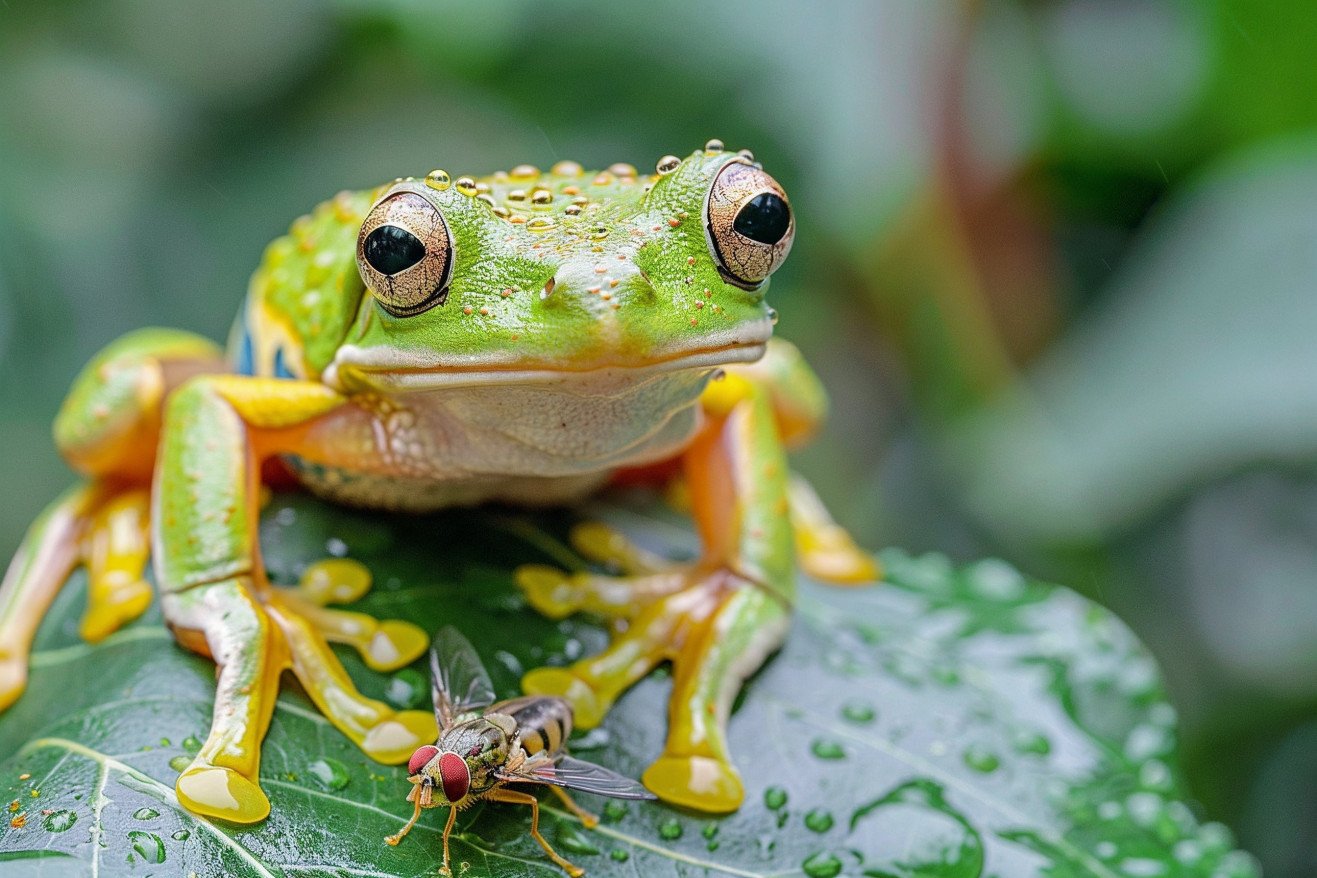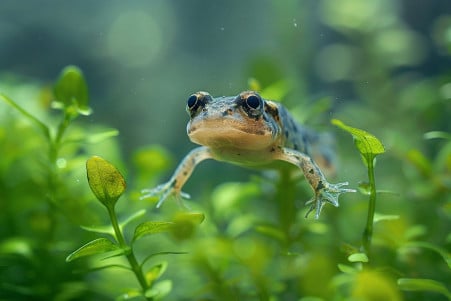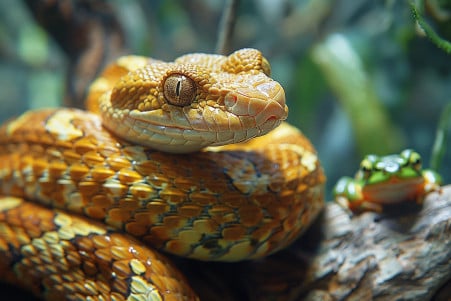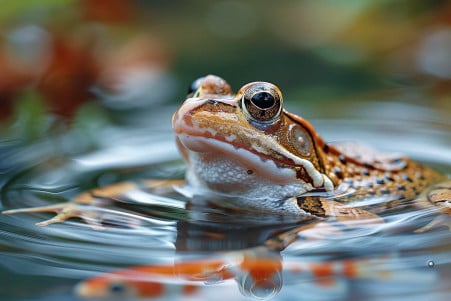Do Frogs Eat Meat? A Look at Their Carnivorous Diet
11 March 2024 • Updated 9 March 2024

Frogs are famous for catching bugs with their long, sticky tongues, but is that all they eat? Frogs are mostly carnivorous, especially in their adult stage, and eat a diet of insects and other small animals. Tadpoles, on the other hand, are herbivorous and eat algae and plants until they go through metamorphosis. The only exception is the Izecksohn’s Brazilian treefrog, which is a strict frugivore.
To better understand the eating habits of frogs, we will look at a number of biological and ecological studies. Our research will include a focus on zoological studies that look at how diets change from the tadpole stage to the adult frog stage and whether frogs are ever omnivorous.
We will also consider ecological studies that look at the role of frogs in their ecosystems, providing a comprehensive view of their eating habits and their role in the larger environment.
Do frogs eat meat?
Adult Frogs Are Carnivorous and Have Specialized Diets
Adult frogs are skilled hunters and eat a wide range of insects and other small animals. Hepper’s study shows that adult frogs have a strong preference for live prey and eat a variety of insects, including spiders, grasshoppers, mosquitoes, and midges. This carnivorous diet is made possible by a number of physiological adaptations, including the use of their sticky tongues and quick reflexes to catch their prey.
Feeding adult frogs plant material can be fatal because their digestive systems are not equipped to process it. Instead, they need a protein-rich diet, which they get from the insects they eat, to stay healthy and strong. The specialized diet of adult frogs is important to the environment because it helps keep insect populations in check, which in turn helps prevent the spread of diseases and keeps the ecosystem in balance.
Zoo Atlanta points to the Izecksohn’s Brazilian treefrog as an example of an adult frog that doesn’t follow the typical carnivorous diet. Instead, this species is frugivorous, meaning it eats fruit. While this is an example of the diversity and nuance of frog diets, it is the exception to the rule of adult frogs being primarily insect eaters.
Understanding these diets is important for understanding frogs’ role as natural pest control and their place in the ecosystem.
Tadpole’s Plant-Based Diet
One of the most fascinating aspects of the frog life cycle is the shift from a plant-based diet to a meat-based diet. Tadpoles eat algae and plants, and this diet is important for their early development.
The yolk in their eggs sustains them at first, but they quickly move on to eating plants. At this point, their digestive system is able to break down the cellulose in plants, which is consistent with the type of food they eat.
As explained by Developmental Biology on NCBI Bookshelf, the frog’s digestive system changes a lot during metamorphosis. The intestines go from being able to digest the soft plant matter that the tadpole eats to the high-protein diet of an adult frog. This change is controlled by hormones that also control the rest of the metamorphosis process.
Metamorphosis not only changes the frog’s body, but it also changes its diet, making it more carnivorous as it develops the ability to hunt.
Many studies have looked at the role of nutrition in the success of metamorphosis, and it’s clear that nutrition is important during this time. As the frog continues to metamorphose, its body becomes more and more adapted to life on land. This is a sign that the tadpole’s plant-based diet is ending and its meat-based diet is beginning.
Frogs Are Keystone Species
Frogs are considered a keystone species in many ecosystems. As predators, their carnivorous diet is essential for controlling insect populations, which, according to HowStuffWorks, can have a big impact on the health of entire ecosystems. By eating billions of insects every year, frogs are important for the economy of agriculture and for controlling the spread of diseases that insects carry.
Frogs have a huge impact on biodiversity and ecosystem health. As both predators and prey, frogs are vital to the food web. According to the American Museum of Natural History, frogs are a major food source for birds, fish, and snakes. The way frogs eat impacts predator-prey dynamics, which can influence the survival and reproduction of other species.
As shown by research covered by Phys.org, which was led by Dr. Jodi Rowley, frogs are a sign of ecosystem health. The way frogs eat, especially as top-level predators in their adult form, has far-reaching consequences. If frogs disappear, pest populations could grow and waterways could suffer, while their presence is often a sign of a healthy ecosystem.
Given the many ways frogs contribute to their ecosystems, from filtering water as tadpoles to controlling insect populations as adults, their classification as carnivores is more than just a scientific detail; it’s an ecological necessity. This necessity is at the heart of their impact on the delicate balance of life in their environments, a subject that’s closely tied to the evolutionary adaptations of their digestive systems.
Inside the Digestive System of Frogs
The digestive system of frogs, as explained by Online Biology Notes, is an example of the way evolution has shaped the body to fit a specific diet. It starts with a large mouth that hides a muscular, sticky tongue that is perfect for catching prey.
Once the prey is caught, it moves through a coiled gut that runs from the mouth to the cloaca—that includes the stomach and intestines, which are both specialized to break down animal-based food.
The stomach breaks down the food with the help of enzymes, including pepsin, and acids. This is followed by the small intestine, which is aided by secretions from the liver and pancreas, that finishes breaking down the food and helps the body absorb the nutrients. This highly specialized carnivorous system is not well-equipped to digest plant-based food, which shows that frogs are naturally inclined to eat a diet that is high in animal protein.
A study in PMC shows that the digestive system of frogs goes through a number of changes during metamorphosis.
The gut goes from a simple tube that is designed to process the plant-based diet of a tadpole to a complex system that is ready to process a carnivorous diet.
These changes are the result of a combination of genetic and environmental factors, which shows how the digestive system of frogs has evolved in a way that is both flexible and adaptive.
Studying Plant Consumption in Frog Diets
While frogs are mainly carnivorous, there have been documented cases of frogs eating plants. Frogs have been known to eat soft, easily digestible plants like aquatic plants, cabbage, lettuce, kale, and watercress to get nutrients that aren’t found in insects. A report from Flourishing Plants notes that while plant consumption is unusual, it is not unheard of and can happen, especially when other food sources are limited or in specific environments.
The nutritional role of plants in a frog’s diet is complex. For example, American toad tadpoles have been observed to eat small amounts of plant material, which may provide vitamins and nutrients that are different from those found in their typical insect prey. However, this is not evidence of an omnivorous diet but rather an example of occasional opportunistic feeding.
A study from ScienceDirect on the Tibetan frog Rana kukunoris shows that frogs can have an indirect impact on plants. By eating detritivores, these frogs decrease plant biomass, which shows the complex relationship between their carnivorous diet and the larger ecosystem.
While there is evidence that some frogs occasionally eat plants, it is not enough to change their classification as carnivores to omnivores. Most frog species, including the extensively studied Green Frog and the Amazon milk frog, as reported by Reptile Knowledge, are primarily invertebrate eaters. The range of frog diets shows their flexibility within their ecological niches but also confirms their primary classification as carnivores.
In Conclusion: The Diets of Frogs from Tadpole to Adult
A survey of the many different types of frog diets shows that adult frogs are mostly carnivorous, while tadpoles are almost exclusively herbivorous during their early life stages. Scholars note that this dichotomy is important for the frogs’ growth and their place in the ecosystem. By eating insects and other small animals, adult frogs help keep pest populations in check, which helps maintain ecological balance and shows how important frogs are as bioindicators.
While there are a few examples of frogs eating plant material, like the Izecksohn’s Brazilian treefrog’s unusual love of fruit, these examples don’t change the overall picture of frogs as carnivores. The complex way that frogs interact with their environments shows how important it is for researchers to know what frogs eat, both for conservation and ecological research.
But knowing what these amphibians eat is more than just an academic exercise—it’s a reminder of the rich web of life and the way that different species depend on each other in ecosystems. Frogs, with their small but important role, remind us that every living thing, no matter how small, is important in the natural world.


